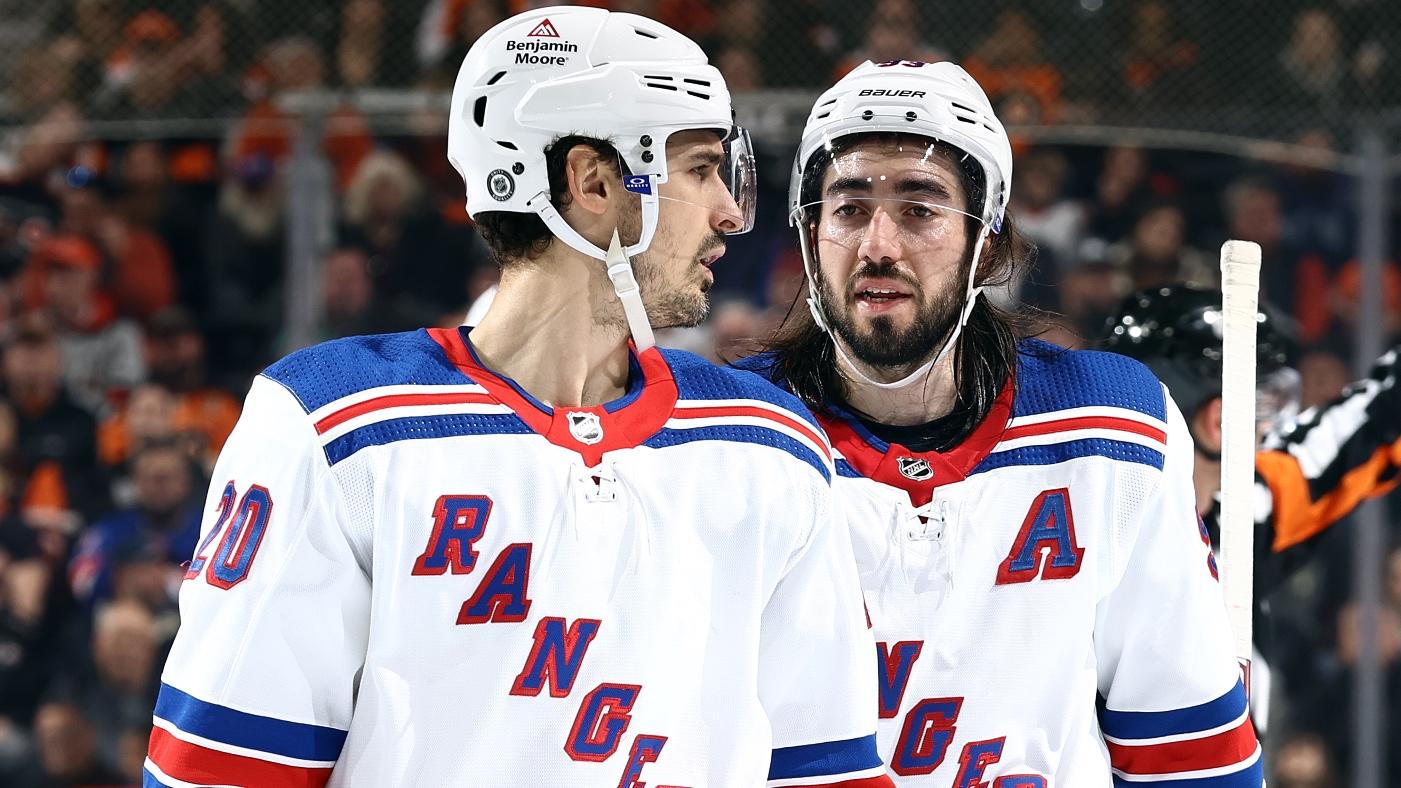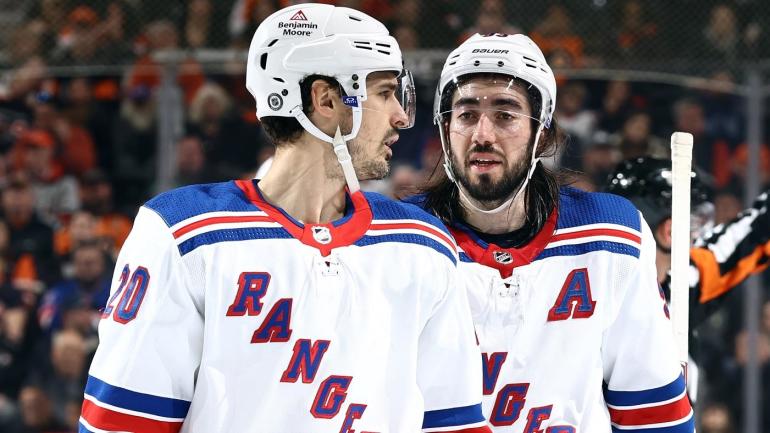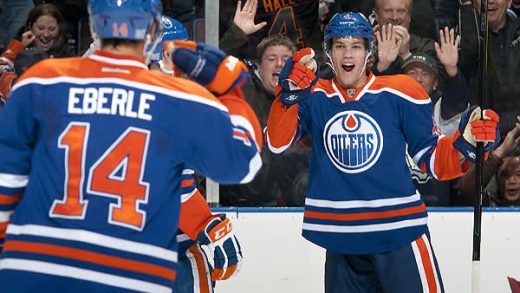

The New York Rangers entered the 2024-25 season with Stanley Cup expectations. The team played up to those expectations for about six weeks before slipping into a seemingly inescapable downward spiral.
Coming off an Eastern Conference Final appearance in which they pushed the eventual Stanley Cup champs to six games, the Rangers looked poised for another deep postseason run. Through Nov. 20, all was well with the blueshirts. New York was 12-4-1, good for the fifth best record in the NHL and three points back of the Metro Division lead.
One day later, the Rangers suffered a 3-2 loss at the hands of the Calgary Flames, and that kicked off a slump that’s been as alarming as it is puzzling.
In its last 22 games, New York is 6-16-0 with a minus-30 goal differential, both of which are good for last in the NHL. Throughout this stretch, the Rangers have tumbled to seventh place in the division and 14th place in the East. In the process, they traded their captain and a former No. 1 overall pick, and they’ve healthy scratched one of the franchise’s greatest goal-scorers.
So, what’s gone wrong with the Rangers? And can they fix it in time to salvage the season?
When a boat is springing new leaks faster than they can be patched, it can be hard to identify the biggest problems. That’s certainly the case in New York, but the team’s issues ultimately boil down to three things. Poor team defense, a lack of production from key players and an anemic power play have sent the Rangers plummeting down the standings.
Let’s take a look at each of those fatal flaws and see whether they can be remedied.
The Problem: Defense
There’s a strong case to be made that the Rangers are the worst defense team in the NHL. New York has only allowed 123 goals this season, which is 17th in the league. The only reason the team ranks that high is due to the efforts of Igor Shesterkin and Jonathan Quick between the pipes.
In terms of expected goals, the Rangers allow 3.53 xGA/60, per Natural Stat Trick. Over the last 22 games, that number has slipped to 3.7 xGA/60, which is the worst mark in that span.
When analyzing a team’s defense, it’s probably appropriate to start with … well … the defense. Perhaps unsurprisingly, the Rangers have been a complete mess in their own zone, with the lone exception of Adam Fox. The dip in the team’s five-on-five performance with Fox in the game and on the bench is drastic.
|
xG share |
Goal differential |
|
|
With Fox |
57.8% |
+9 |
|
Without Fox |
43.5% |
-13 |
The only other Rangers defensemen above 50% in five-on-five expected goals shared are Ryan Lindgren and k’Andre Miller, and they are just barely above water after a lopsided win over the Chicago Blackhawks on Sunday. The results tell more of the story, as Lindgren has a goal differential of minus-5, and Miller’s is minus-6.
Braden Schneider provides some juice offensively, but anything he creates in that zone gets erased when he hemorrhages chances and expected goals on defense. Zac Jones has shown some skill, but he also makes too many critical mistakes.
Out of the entire group, Miller is probably the most disappointing. The 24-year-old former first-round pick has yet to take the next step in a contract year. Miller is slated to be a restricted free agent in the summer, and his future with New York is now up in the air.
Of course, hockey is a team game, and all five skaters are responsible for what goes on in the defensive zone. That being the case, the Rangers’ forwards are just as culpable for the leaky defense as the defensemen, especially when it comes to stopping opponents off the rush.
The biggest offender is also one of the team’s biggest stars, Mika Zibanejad. It’s been a rough season for Zibanejad in more than one area, but his defensive issues are the most concerning. According to Natural Stat Trick, the Rangers are allowing 3.25 xGA/60 with Zibanejad on the ice at five-on-five.
Out of 610 players with at least 200 min of ice-time, Zibanejad ranks 601st in that category.
Chris Kreider, who was a healthy scratch on Dec. 23, isn’t faring much better than Zibanejad. He ranks 563rd in xGA/60 at 2.96. Artemi Panarin is tied with Kreider in that department, but at least he has been able to cover it up with some offense.
The Solution
Barring a drastic shift in scheme midseason, which seems unrealistic and impractical, the Rangers need a personnel upgrade in order to strengthen the defense.
New York does have a few options to find an internal upgrade on the blue line. The most obvious is that Miller, a player who’s shown immense potential in the past, finds another level to his game.
Newly acquired defensemen Will Borgen and Urho Vaakanainen could also help out once they find their footing, although the early returns for the former aren’t terribly promising. Vaakanainen was a first-round pick in 2016, so he has the pedigree to become a reliable player, but not many players break out at 26.
More than likely, however, Rangers general manager Chris Drury will have to look outside the organization for a top-four defenseman. Unfortunately for him, it’s a tough time to be in the market for a defenseman with no obvious high-end trade targets.
Having said that, New York could target Nashville’s Jeremy Lauzon or Philadelphia’s Rasmus Ristolainen. Both have term left and would be a clear upgrade on the Rangers’ blue line, at least defensively. Drury could also check on Buffalo defenseman Bowen Byram, who is set to be an RFA after this season.
Seattle forward Yanni Gourde might also be an option if New York wanted to add some defensive prowess to its forward group. Gourde is on an expiring contract, so he would most likely be a rental.
The Problem: Lack of production from key players
Over the last handful of years, the Rangers haven’t been a dominant team at five-on-five. Instead, they have leaned on elite scoring and goaltending to paper over other issues, which worked for them.
This season, that finishing ability has disappeared. The general lack of defense from Zibanejad and Kreider would be less of a problem if they were lighting the lamp on a regular basis, but that hasn’t been the case.
Zibanejad recently ended an eight-game goal drought with goals in back-to-back games, but he’s still on pace for just 16 goals after scoring 26 in 2023-24. Kreider is on pace for 31 goals, and while that’s a respectable total, it would be his lowest output since the pandemic-shortened 2020-21 season.
One of the reasons Zibanejad and Kreider might be scoring less is that they’re putting fewer pucks toward the net. Both players have experienced a clear drop in both shot attempts and shots per game.
While shot volume, or a lack thereof, plays a role in these problems, it doesn’t tell the whole story. There’s no doubt the team’s poor defense has an impact because it’s hard to score goals when the opponent is constantly parked in your defensive zone.
There’s also the question of age. Kreider is 33 years old, and Zibanejad is 31. When players exhibit a decline in production at those ages, it’s a potential red flag. Is this a blip on the radar for two of the Rangers’ best players, or is it a sign of Father Time taking his toll?
The proven veterans aren’t the only ones having trouble finding the scoresheet. Alexis Lafreniere hasn’t recorded a goal in his last 13 games, and he has just two assists in his last 10 games.
In his case there may be some poor luck involved because his five-on-five impacts have been better than most of his teammates. One hot streak will put Lafreniere right back on track.
Not even Fox has been immune to the Rangers’ toothless offense. Fox has scored one goal after tallying 17 last season, and his shooting percentage is a paltry 1.6%. Even for a defenseman, that’s shockingly low. Fox’s struggles can likely be chalked up to bad puck luck, even more so than Lafreniere, but the Rangers are running out of time for that luck to turn.
The Solution
There is a very simple solution to this: Kreider and Zibanejad start producing at a rate closer to their career averages. Lafreniere snaps out of his funk. Fox finally starts getting some of his shots through to the back of the net.
It’s not outlandish to think all of those things could happen because we’ve seen those players produce at a high level as recently as last year. Having said that, the lack of scoring seems to be bigger than low shooting percentages, especially in the case of Zibanejad and Kreider. If those two are really on the decline, the solution gets more complicated.
In that case, the Rangers will need to bring in more offensive firepower. Fortunately for them, another team in turmoil seems ripe for a trade. The Vancouver Canucks are rumored to be hearing offers on stars J.T Miller and Elias Pettersson. New York has reported interest in Miller, but either player could provide a spark for this lineup.
It will take more than Zibanejad or Kreider to land Miller or Pettersson, so the Rangers will have to attach something else to the deal.
The complicated part of a deal between the Canucks and Rangers is that the latter team doesn’t have a ton of future assets. The Rangers’ prospect pool isn’t exactly deep, and while they do have a first-round pick in each of the next three drafts, they don’t possess a second-round pick in any of them.
If New York can’t come to an agreement with Vancouver, maybe it could pry Dylan Cozens away from the Buffalo Sabres. Cozens has been rumored to be on the trade block, and he would provide youth and skill to a lineup that desperately needs both of those things right now.
The Problem: Anemic power play
Another thing the Rangers have leaned heavily on in their current era is a lethal power play. Last season, they converted on 26.4% of their man advantage opportunities, which was third in the NHL.
In 2024-25, that number is down to just 17.1%, which puts the Rangers at 26th in the league. They’re behind teams with considerably less skill, including the San Jose Sharks, Seattle Kraken and Calgary Flames.
When taking a deeper look at the Rangers’ power play, it’s easy to see why those players haven’t been scoring as much. According to Natural Stat Trick, the New York power play creates high-danger scoring chances at the 17th highest rate in the league. It was sixth in that category last season.
|
HDCF/60 |
xGF/60 |
Goals/60 |
|
|
2023-24 |
30.2 |
9.75 |
10.12 |
|
2024-25 |
23.5 |
8.50 |
6.23 |
As a result of that decline in effectiveness, the team’s top players are feeling it on the stat sheet. Fox, Zibanejad, Kreider and Vincent Trocheck have combined for nine power play goals. That quartet totaled 47 power play tallies in 2023-24.
All of this can be explained by the Rangers’ lack of shot attempts from the low slot, which is where they have excelled in recent years. More specifically, that’s where Kreider has made his money with deflections and rebounds galore. The team has had a harder time getting the puck into that high-danger area of the ice, and it hasn’t been able to punish opposing penalty kills as often.
The Solution
With the team unable to create much of anything on the man advantage, Peter Laviolette may want to make some personnel changes on his top unit. That has already happened with Will Cuylle seeing more power play time of late, and that may need to continue.
Cuylle has yet to score a goal in 32 minutes of power play time, but he has been able to generate expected goals and scoring chances. Besides, Cuylle seems to be one of the few players on the Rangers with any amount of juice at all this season. His 11 goals are tied for third on the team and two away from a career high. He has probably earned more ice time on the man advantage.
Beyond that, the Rangers need to get the puck into the low slot more often, one way or another. Maybe that means letting Fox get more aggressive from the point in hopes of drawing more attention away from Kreider down low, or perhaps it’s just a matter of Zibanejad connecting on more one-timers from the left circle. Either way, the Rangers’ power play will never improve until it gets back to those high-value areas on the ice.
As was laid out earlier, bringing in outside help could also give this power play a boost. The only concern is, if the Rangers do acquire Miller, he’s been unusually cold on the man advantage this year too. After posting 21 goals and 70 points on the man advantage from 2022-2024, he has one goal and 10 points in 2024-25.
The New York Rangers have had a disappointing start to the 2021-2022 NHL season, currently sitting near the bottom of the Metropolitan Division. In order to turn their season around and get back on track, there are three key issues that the team must address.
First and foremost, the Rangers need to improve their defensive play. The team has struggled to keep the puck out of their own net, ranking near the bottom of the league in goals against per game. This can be attributed to a combination of poor defensive zone coverage, turnovers in their own end, and subpar goaltending. In order to turn things around, the Rangers need to tighten up defensively, limit their turnovers, and get better play between the pipes.
Secondly, the Rangers need to find more consistency in their scoring. While they have shown flashes of offensive firepower at times this season, they have also been shut out multiple times and have struggled to score goals on a consistent basis. The team needs to find a way to generate more offense and capitalize on their scoring chances in order to start winning games.
Lastly, the Rangers need to address their special teams play. Their power play has been inconsistent at best, ranking near the bottom of the league in power play percentage. On the flip side, their penalty kill has also struggled, giving up too many goals while shorthanded. Special teams can often be the difference maker in close games, so the Rangers need to improve in this area if they want to start winning more games.
In conclusion, the New York Rangers have some work to do in order to turn their season around. By addressing their defensive play, finding more consistency in their scoring, and improving their special teams, the team can start to climb up the standings and get back into playoff contention. It won’t be easy, but with some adjustments and hard work, the Rangers have the potential to turn things around and salvage their season.


